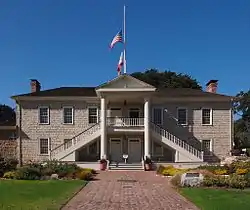California Constitutional Conventions
The California Constitutional Conventions were two separate constitutional conventions that took place in California during the nineteenth century which led to the creation of the modern Constitution of California. The first, known as the Monterey Convention, held in September and October 1849 in advance of California attaining U.S. statehood the following year, adopted the state's original constitution.[1] This document maintains jurisdiction along with the current constitution[2] which was ratified on May 7, 1879, following the Sacramento Convention.[3] Article 3 Section 2 of the current Constitution references the original boundaries[4] as stated in the 1849 Constitution at Article 7.[5] The result of Progressive mistrust of elected officials, this later constitution took a full year to finalize (March 1878 to March 1879)[6] and is today the third longest in the world (behind the constitutions of Alabama and of India),[7] and has been described as "the perfect example of what a constitution ought not to be".[8] Multiple calls for a third state constitutional convention have been raised during the past quarter-century, but none has thus far gained widespread political momentum.

Monterey Convention of 1849

The Monterey Convention of 1849 was the first California Constitutional Convention to take place.[1][9][10] Bvt. Brig. Gen. Bennett C. Riley, ex officio Governor of California, issued a proclamation on June 3, 1849 calling for a convention and a special election on August 1 where delegates to the convention would be elected.[1]
The memorial presenting the proposed constitution to Congress claimed it banned slavery not because of anti-slavery sentiment, but just unanimous agreement (including convention delegates originally from slave states) that California's climate and soil were not suitable for slave labor. It also described the proposed eastern boundary as a compromise between those who wished to include all of former Mexican Alta California (including today's Nevada, Utah, and Arizona) and a committee-proposed eastern boundary at 116° (including the western half of Nevada but excluding the Lower Colorado River Valley and Imperial Valley), and denied having considered north–south division at the Missouri Compromise Line (south of Carmel and Fresno), saying Southern Californians had no interest in division.[1]:xix
Sacramento Convention of 1878–79
The Sacramento Convention of 1878–79 amended and ratified the original 1849 constitution.[11][12][13] It took place in Sacramento, California from March 1878 to March 1879. The new California Constitution produced by the Convention was voted for on May 7, 1879, and adopted by a vote of 77,959 to 67,134.[14]
References
- Report of the Debates in the Convention of California on the Formation of the State Constitution in September and October, 1849. United States Congress. 1850.
- https://www.law.cornell.edu/supct/html/historics/USSC_CR_0074_0700_ZO.html
- Grodin 8, 16.
- "Archived copy". Archived from the original on February 2, 2014. Retrieved January 23, 2014.CS1 maint: archived copy as title (link)
- "Archived copy". Archived from the original on January 28, 2010. Retrieved January 23, 2014.CS1 maint: archived copy as title (link)
- 1878–1879 Constitutional Convention Working Papers Archived 2010-01-28 at the Wayback Machine, California State Archives
- Janiskee, Brian; Ken Masugi (July 27, 2007). "2". Democracy in California: Politics and Government in the Golden State (2 ed.). Rowman & Littlefield Publishers, Inc. p. 27. ISBN 978-0-7425-4836-7.
- Wilson and Ebbert via Korey 11. Korey states, "The convention did succeed in producing what one writer has called 'a document that was the perfect example of what a constitution ought not to be.'" The work cited is Wilson and Ebbert, California's Legislature.
- Biographical sketches of the delegates to the convention to frame a new constitution for the State of California, 1878 : together with a succinct review of the facts leading to the formation of the Monterey Convention of 1849, a list of its members, and the Constitutional Act of 1878
- A Humorous Account of America's Past: 986 to 1898
- Kogan, Vladimir; Binder, Michael (2017). "Parties Without Brands? Evidence from California's 1878–79 Constitutional Convention". Studies in American Political Development. 31 (1): 68–87. doi:10.1017/S0898588X17000025. ISSN 0898-588X.
- Los Angeles Herald - 1879
- Rose Institute - Original Intent of California's Blaine Provision
- Sargent, Noel. The California Constitutional Convention of 1878-9. California Law Review, volume 6, number 1, Nov. 1917. Available online at JSTOR
External links
- Repair California, a group advocating for a constitutional convention
- California Constitutional Convention Summit
- Recommendations of the 1996 California Constitutional Revision Commission
- The California Constitution Wiki, a wiki project to re-design the state's constitution
- Works by California Constitutional Conventions at LibriVox (public domain audiobooks)
